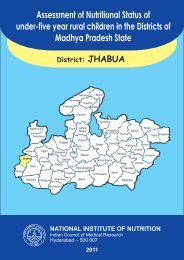Assessment of Nutritional Status of under-five year rural children in ...
Assessment of Nutritional Status of under-five year rural children in ...
Assessment of Nutritional Status of under-five year rural children in ...
You also want an ePaper? Increase the reach of your titles
YUMPU automatically turns print PDFs into web optimized ePapers that Google loves.
5. DISCUSSION AND CONCLUSIONSNational population policy 2000 envisaged that about 80% <strong>of</strong> deliveries shouldbe Institutional and 100% should be conducted by tra<strong>in</strong>ed personnel 16 . The presentstudy revealed that only 68% were <strong>in</strong>stitutional deliveries conducted by tra<strong>in</strong>edhealth personnel. Sixty seven per cent <strong>of</strong> pregnant women had <strong>under</strong>gone antenatalcheck-up. However, 26% had <strong>under</strong>gone the m<strong>in</strong>imum 3 ANCs. About 86% receivedTT immunization <strong>in</strong> the Damoh district <strong>of</strong> Madhya Pradesh. Accord<strong>in</strong>g to NFHS-3survey, about 80% <strong>of</strong> the pregnant women had <strong>under</strong>gone ANC <strong>in</strong> the state <strong>of</strong>Madhya Pradesh 10 .Birth weights were recorded <strong>in</strong> about 60% <strong>of</strong> the newborns, but the recordswere available for only 36% <strong>of</strong> them. The proportion <strong>of</strong> low birth weight (LBW) wasabout 31% <strong>in</strong> the district. The birth weight <strong>of</strong> an <strong>in</strong>fant is the s<strong>in</strong>gle most importantdeterm<strong>in</strong>ant <strong>of</strong> new born survival and <strong>in</strong> develop<strong>in</strong>g countries; low birth weight <strong>in</strong>fantsare at <strong>in</strong>creased risk <strong>of</strong> be<strong>in</strong>g malnourished at one <strong>year</strong> <strong>of</strong> age, become victims <strong>of</strong>“<strong>in</strong>fection-malnutrition cycle” which leads to further physical stunt<strong>in</strong>g and impairedgrowth and development. 17 In addition, <strong>children</strong> born with <strong>in</strong>trauter<strong>in</strong>e growthretardation are at higher risk <strong>of</strong> develop<strong>in</strong>g overweight/obesity and associatedchronic degenerative disorders dur<strong>in</strong>g adulthood 6 .Infant and young child feed<strong>in</strong>g practices have a significant impact on childhealth and survival. Appropriate feed<strong>in</strong>g <strong>in</strong>clud<strong>in</strong>g early and exclusive breastfeed<strong>in</strong>gand optimal complementary feed<strong>in</strong>g practices such as right time <strong>of</strong> <strong>in</strong>itiation, righttype and quantity <strong>of</strong> complementary foods and frequency <strong>of</strong> complementary feed<strong>in</strong>gis important for proper physical growth and mental development <strong>of</strong> the child. In itspolicy statements, the American Academy <strong>of</strong> Paediatrics (1997) 18 stated that themother’s milk is uniquely superior for <strong>in</strong>fant feed<strong>in</strong>g.Epidemiological research showed that mother’s milk and breastfeed<strong>in</strong>g <strong>of</strong><strong>in</strong>fants provides advantages with regard to general health, growth and developmentwhile significantly decreas<strong>in</strong>g risk for a large number <strong>of</strong> acute and chronic diseases.In this study, breastfeed<strong>in</strong>g was the common practice among the mothers. About35% <strong>of</strong> the mothers reportedly <strong>in</strong>itiated breastfeed<strong>in</strong>g with<strong>in</strong> one hour after deliverywhich is higher than that reported by NFHS-3 (16%), while 26% <strong>of</strong> mothers <strong>in</strong>itiatedbetween 1-3 hours. Pre-lacteals were given <strong>in</strong> about 29% <strong>of</strong> the newborns. Prelactealfeeds might harm the immature gut <strong>of</strong> the child, especially if they arecontam<strong>in</strong>ated. These undesirable newborn feed<strong>in</strong>g practices observed <strong>in</strong> the districtis a matter <strong>of</strong> concern and requires due attention because, early <strong>in</strong>itiation <strong>of</strong> breastfeed<strong>in</strong>g is the primary determ<strong>in</strong>ant <strong>of</strong> maternal milk production and secretion.Avoidance <strong>of</strong> other fluids or foods is essential to optimize breast milk <strong>in</strong>take by thenewborn. Most <strong>of</strong> the other fluids or foods are less nutritious than breast milk andtherefore, if displacement occurs, the <strong>in</strong>fant may be at a nutritional disadvantageeven if prepared hygienically 19 . In many communities, it is traditionally believed thatcolostrum is unhealthy and therefore is harmful to the baby. However <strong>in</strong> the present<strong>Nutritional</strong> <strong>Status</strong> <strong>of</strong>
















